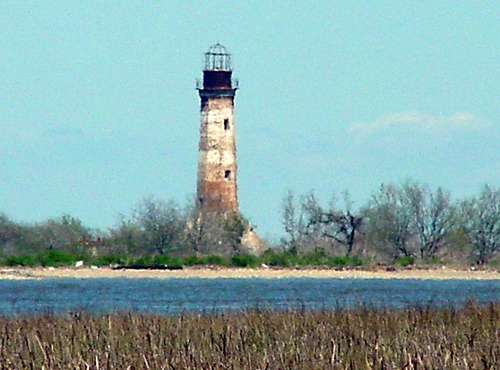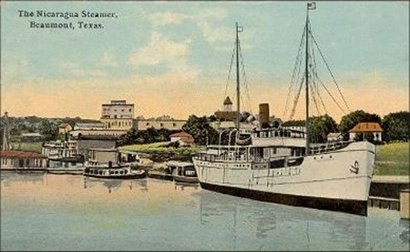|
The
early sailboats on the Calcasieu and Mermentau rivers were probably
Jean Lafitte’s pirate
ships, most of which are unknown by name. According to popular legend,
Lafitte made a number of trips up the Calcasieu to Lake Charles, where
Charles Sallier was a close friend of his. According to Willard Richardson
(editor of Galveston Weekly News, May, 1866), Lafitte landed many
slaves on Contraband Bayou at Lake Charles, from whence they were
sold to the sugar plantation owners.
The only pirate ship that can be identified by name was the “Hotspur,”
which sailed up Mermentau River in Nov. 1820 to refill its fresh water
supply. At that time, 2 crewmen jumped ship, one being Jean Baptiste
Callistre, who swam ashore and eventually returned to Saint Martinsville;
when he was 90 years old, he was still living on Calcasieu River at
Lake Charles. Cabin boy Charles Cronea also deserted and lived with
the Attakapas Indians at Grand Chenier for 2 years; and he eventually
married an Attakapan woman. On leaving the river, the “Hotspur” wrecked
on a mudflat at the mouth of the Mermentau and later washed out to
sea; the wreck had a fortune of pirate treasure aboard.
Between 1838-1848, some Grand Chenier families had resettled from
Mississippi, traveling first to New Orleans, where they boarded a
schooner bound for Grand Chenier {ie: these included my great Grandpa
J. W. Sweeney and family}. Dr. George Carter Sweeney believed that
first schooner was the “Jubilee,” captained by Paul Jones, formerly
of Massachusetts. Jones made round trips, bringing dry goods, foodstuff
and hardware from New Orleans, which he traded for deer skins, peltries,
and sometimes cotton. Oak forests at Grand Chenier often had to be
cleared first to prepare a cotton field.
According
to Richard Vaughn and Sen. Aladan Vincent, there were a number of
sail boats on both rivers before and after the Civil War, about which
little information or dates of service have survived. Two of them
were the schooners “Chafana,” captained by Eugene Laurents, and the
“Flower France,” manned by Capt. Louis Zampini.
Other early schooners included the “Mary Lee,” the “Catherine Minerva,”
built by E. A. Perkins and captained by Joe Wainwright. Lastie Vincent
bought the schooner “Ramsey” from Capt. John Miller of Grand Chenier.
The schooner “John Albert” was also in the early trade under Capt.
William Vincent. The first steamboat on the Mermentau was the “Cricket,”
under Capt. Joe Boudreaux, which carried mail and supplies to Grand
Chenier and returned to Lake Arthur with cotton, cattle, hides, and
produce.
A very unusual boat arrived in Sabine Lake during the 1830s, being
the English bark “Elizabeth,” carrying a load of African slaves. In
1837, the “Elizabeth” was observed at anchor at the mouth of Johnson’s
Bayou for 2 months, while the crew cut and loaded a cargo of cypress
logs before returning to England.
Johnson’s Bayou was perhaps the first place in Cameron Parish to grow
cotton, although Grand Chenier followed quickly after 1845. The earliest
settlers on the bayou were Dan Johnson, who was a smuggler there in
1790, followed by the Barrows, Henry Orr, and Henry Griffith, who
were cattlemen. The writer’s great grandfather, Frederick Schmidt,
arrived on Smith Ridge in 1839, where he grew cotton and installed
a cotton gin. The writer’s grandfather, James Hill Sweeney, grew about
20 bales of cotton annually at Grand Chenier between 1870 and his
death in 1891. And they and other cotton growers were entirely dependent
on the river schooners to carry their cotton to New Orleans or Galveston.
|
 |
Another early
cash crop in Cameron Parish was satsuma oranges, introduced into the
parish by Valsaint Montie sometime before the Civil War. On one occasion
about 1880, Capt. Emanuel Sturlese of Grand Chenier bid $100 for all
the oranges, believe to number about 5,000, on Montie’s biggest tree.
The actual figure was closer to 10,000, all of which Capt. Sturlese
loaded aboard his schooner “Two Brothers,” and sold in Galveston.
Charles F. Henry of Leesburg (Cameron) was the source of other information.
He recalled that 2 other early schooners on Calcasieu River were the
“Mary Lynch,” manned by Capt. J. B. Quinn, also the “Buck Hart,” under
Capt. Milton Rogers. (Henry may have had an interest in one schooner,
since his grandmother was named Mary Lynch.) Henry also recalled that
the first Cameron to Lake Charles mail steamer, the propeller “Romeo,”
made 2 round trips weekly from 1876 until 1905. According to a Memphis
newspaper account, the “Romeo” capsized and sank at Lake Charles in
May, 1879, but was later re-floated. Although Capt Reynolds and his
engineer swam to shore, the six passengers on board drowned, including
Dora and Medora Pithon, the granddaughters of Michel Pithon and wife,
Denise Sallier.
Henry also noted that around 1900, “as many as seventy to eighty schooners
at one time could be seen and counted in the stretch of river from
3 miles above its mouth to the Calcasieu bar...” Henry’s figure seems
excessive to the writer, and although the Calcasieu lumber fleet sailing
to Galveston
was certainly large, a figure of 40 to 45 schooners seems a more likely
figure. All the schooners had to wait at the bar for maximum high
tide before crossing.
The
Lake Charles to Galveston
lumber trade began about 1855, although perhaps a little earlier at
the Jacob Ryan sawmill. Daniel Goos moved his family and sawmill from
Pearl River, MS. aboard the first schooner “Lehmann,” and reassembled
the mill machinery at Goosport. His son-in-law, Capt. George Locke,
soon built his mill at Prien Lake, near the Ryan mill, and within
a year the Goos and Locke sawmills were exporting 4,000,000 feet of
lumber annually to Galveston.
Goos also resettled about ten German ship carpenters from his place
of birth, the Island of Fohr, off th coast of Denmark, and he founded
the Goos shipyard, which was to build many more of the old Calcasieu
schooners. Over the years, the Goos schooners included the second
vessel named “Lehmann,” the “Lake Charles,” “Winnebago,” “Cassie,”
and “Emma Thornton,” one or more of which were Confederate blockade-runners
during the Civil War.
On July 4, 1861, the Jacob Ryan schooner, “Ann Ryan,” loaded with
lumber, was captured at Galveston
by the Union blockader, “South Carolina.” However the “Ryan” was permitted
to dock in Galveston
because lumber was not listed as contraband cargo. Since lumber was
no longer in demand during the Civil War, the “Ann Ryan” was converted
to a blockade-runner, renamed the “Stingray,” and it acquired a remarkable
record of running cotton past the Galveston
blockaders.
According to Galveston Tri-Weekly News of Dec. 15, 1857, as follows:
“...Capt. Goos has built for $10,000 a steamboat named “Dan” to overcome
the difficulties of navigation in Calcasieu River....” Whenever there
was no wind, or Goos’ schooners sailed into the timberline, they often
had insufficient wind to fill their sails, so by building the “Dan,”
Goos intended to tow his schooners into port or to the Calcasieu River’s
bar. Often his towlines hooked on to other schooners as well and towed
them too as a courtesy to his neighbor sawmillers.
The “Dan” was a 112-ton side-wheeler, 23 feet wide and 90 feet long,
and could carry about 500 bales. It was built of white oak timbers,
with a V-bottom deep-sea hull. During the first year of the war, the
“Dan” ran the blockade 3 times to Matamoras, returning with gunpowder,
munitions, medicines, coffee, and bolts of cloth. On Oct. 3, 1862,
14 Union Bluejackets dashed up Calcasieu River with a 6-pound cannon
in a whale boat, and captured the “Dan,” upon which they mounted a
30-pound cannon. They then brought the ‘Dan” to Sabine Lake, where
for 3 months the “Dan” and its cannon terrorized Sabine
Pass. During a dense fog on Jan. 8, 1863, 9 Confederate cavalrymen
paddled up to the “Dan,” anchored at Sabine Lighthouse, set it ablaze
until it exploded and sank. |
 |
The decommissioned
Sabine Pass Lighthouse
TE photo, March 2007 |
|
During
the next two years, many blockade runners, including the “Mary Ann,”
“Conchita,” “Eliza,” “Blue Bell,” “ Revenge,” “Pushmataha,” “J.
W. Wilder,” “Maria Alfred,” “Mandoline,” “Concordia,” and many others
(along with the Goos schooners) entered and exited the Calcasieu
and Mermentau rivers with clocklike frequency, for there was no
permanent blockade of the rivers until after May 6, 1864. Confederate
Lt. Aikens once feared that the 200 Mermentau Jayhawkers would attack
2 blockade-runners at anchor in Mermentau River and steal the 800
kegs of gunpowder that were aboard them.
In May, 1863, the Confederate steamer “T. J. Smith” was docked at
Lake Charles, where it was reported as “inoperable.” The steamer
had been confiscated from the notorious Henry Clay Smith, who had
defected to the North. Later the “Smith” was sunk south of Cameron
when it was intercepted by a blockader or a Union gunboat.
On May 6, 1864, the Sabine Pass garrison caught the Union gunboats
“Wave” and “Granite City” at anchor opposite the Leesburg courthouse.
Following 90 minutes of battle and endless cannonading, the gunboats
surrendered, and both were converted to blockade-runners. The “Granite
City,” renamed the “Three Sisters,” was driven ashore at Velasco,
Texas, and its load of cotton was burned. The “Wave” escaped
to Vera Cruz, where its load of cotton was sold, and the “Wave”
was sold to new owners.
P. E. Smith reported that his father (and my great grandfather),
Duncan Smith, bought a steamboat which he operated on the Calcasieu
for a few years around 1870, but he could not remember what the
name was. Duncan Smith was also a bar pilot for the Calcasieu River,
having piloted the gunboat “Wave” to its anchorage near his home.
During the 1870s 2 other schooners operated between Grand Chenier
and Galveston.
One was Capt. Emanual Sturlese’ “Two Brothers,” which hauled the
load of oranges to Galveston.
The other was Capt. Charlie Sturlese’ “Two Sisters.” One day in
Oct. 1881, my Uncle Andrew Sweeney finshed ginning his 18 bales
of cotton, which he loaded onto the “Two Sisters.” When they sailed,
there were 3 passengers aboard, Sweeney, who hoped to buy his wedding
suit and some furniture in Galveston,
and John Miller, who carried $500 in gold in his money belt. During
the night the “Two Sisters” sprang a leak and sank, and the crew
and passengers floated away on bales of cotton. The next day Sturlese
washed up on the beach, vomiting water but alive. When Miller’s
body was found, his money belt was missing, but the body of Sweeney
was never found. For 2 weeks, Sweeney’s fiancée Margaret Doland
waited with a lantern shining in her window, but Sweeney never returned.
|
|
On
Aug. 22, 1879, a destructive hurricane struck everywhere along the
Louisiana coastline, including much property and maritime damage
at Cameron. Six schooners, 4 steamers, and 3 barges were driven
ashore by the huge tidal wave. The schooners were the “Mary Lynch,”
“Catherine Minerva,” “ Eagle,” “Bee,” “Fanny,” and “Verbena.” The
steamers were the “Pearl Rivers,” “Col. Hooker,” “Alamo,” and “Alert,”
the latter towing 3 barges. The “Alert” belonged to the Louisiana
Western Railroad, and its barges were loaded with railroad iron.
It was believed that many of the vessels could be salvaged and re-floated,
and indeed, the “Pearl Rivers” was on the shipways at Lake Charles
when the hurricane of Oct. 12, 1886 came ashore.
From Galveston Weekly News of Sept. 4, 1879, as follows: “...The
lighthouse was wrenched out for 6 inches, and its beacon light was
carried away...The new cotton gin and press house of S. P. Henry
is prostrated... The houses of Capt. Tom Reynolds, Gus Williams,
Joseph Cormier, and Duncan Smith are washed inland or out to sea,
since they are nowhere to be found... Thousands of cattle are drowned,
and it is reported the damage is even worse at Grand Chenier and
Johnson Bayou...”
Although
at various times there were more than 100 steamboats on Sabine
River, those boats were devoted primarily to Texas commerce.
And only 3 boats are considered pertinent to this essay at Johnson’s
Bayou. Between 1880 and 1886, the population of Johnson’s Bayou
increased to about 1,200 persons prior to the 1886 storm, and many
new settlers had moved in from the northern states.
There were 2 separate towns there, Radford, nearer to the bayou’s
mouth and Johnson Bayou, each town having about 150 permanent residents.
There were also 4 stores - Caswell Peveto, J. C. Griffith, Austin
B. Smith, and Calvin Peveto - as well as 2 cotton gins and grist
mills, 2 sugar mills, and 1 blacksmith shop. In the spring of 1886,
there were 600 acres planted in cotton, expected to yield 900 bales;
200 acres of sugar cane, and about 100 acres planted in Satsuma
oranges.
Two Orange steamboats, the “Emily P.” and the “Lark,” were devoted
almost solely to the Johnson Bayou trade. They carried lumber, firewood,
mail, freight, furniture, hardware, and dry goods to Johnson Bayou,
2 round trips weekly, and returned to Orange,
carrying cattle and other livestock, cotton, hides, peltries, oranges,
and other produce. The schooner “Dreadnaught” remained in the Galveston
to Johnson Bayou trade year round, bringing in mail, freight, and
foodstuffs, and carrying out cattle, mail, cotton, and hides one
roundtrip weekly.
On the night of Oct. 12, 1886, Johnson Bayou was destroyed by a
large hurricane, which drowned 110 persons. The “Emily P.” and “Lark”
brought out about 1,000 refugees, carrying them to Beaumont
and Orange.
Most of them never returned to the bayou, returning instead to their
homes in the north. Others returned to the bayou until there were
57 families living there in 1895.
Another Calcasieu steamer was the ferryboat “Hazel,” which between
1888-1916, made thousands of voyages, one every 2 hours across Calcasieu
River from Lake Charles to Westlake. The Hazel had a maximum capacity
of 300 persons, and when removed from service, it was estimated
to have carried a total of 4 million persons by the time it was
retired in 1916.
The only other boat that space will permit was the “Borealis Rex,”
a steamer which remained in the Cameron-Lake Charles trade from
1905 until 1930. Built at Stillwater, Minnesota in 1888, the “Rex”
was 121 feet long and weighed 89 tons. It had formerly sailed in
the Mississippi and Atchafalaya river trade during its earliest
years. The “Borealis Rex” belonged jointly to T. C. McCain, A. B.
McCain, and J. S. Thomson, who had paid $14,000 for the steamer
at Morgan City.
The “Rex” made 3 round trips weekly to Cameron, leaving Lake Charles
early on Mondays, Wednesdays, and Saturdays under Capt. McCain.
The steamer sank once during the hurricane of Aug. 6, 1918, but
was raised and put back into service in April, 1919. After 25 years
of sailing, the “Rex” was tied up, first because it had lost the
mail contract to Cameron to a faster boat; and secondly, the new
road from Sulphur to Cameron was completed in 1931. (I may be one
of the last persons alive, who at age 11, was waiting with his parents
at Sulphur in 1931 for the ribbon across new Highway 27 to be cut.)
|
 |
The Nicaragura
Steamer, Beaumont,
Texas
Postcard courtesy rootsweb.com/%7Etxpstcrd/ |
Strangely, the
writer can connect some early ship captains with the Galveston
to Lake Charles lumber trade, but not with any schooners’ names. In
1928 Capts. Tom Bergstedt and A. J. Moss lived in retirement at Dutch
Cove, south of Sulphur. Bergstedt had come to Lake Charles in 1869,
and he captained one of “the 40 or 45 lumber schooners between here
(Lake Charles) and Galveston,”
of which he was one. Capt. Charlie Nelson was another who died at
Grand Chenier about 1906. Both Nelson and Bergstedt were natives of
Sweden.
This story could be more complete if records from an early custom
house or steamboat inspection service were available. In the meantime,
many of the early-day schooners and steamers are recalled here for
the benefit of the lovers of maritime history.
© W.
T. Block, Jr.
"Cannonball's
Tales"
September 6, 2007 column |
|
|
